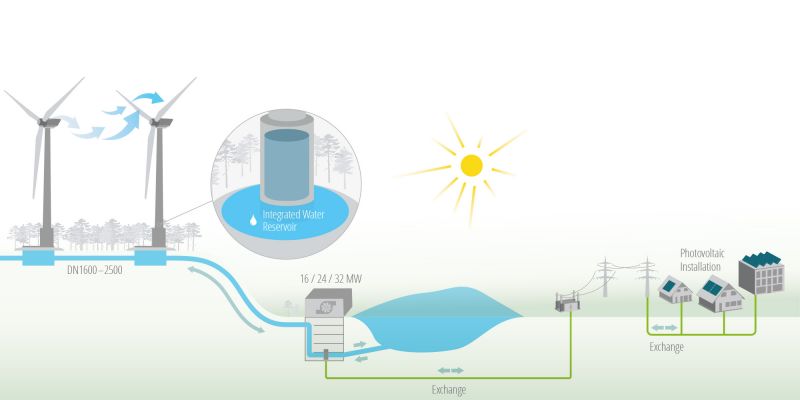Integrating Wind and Water for Renewable Energy
Published on by Water Network Research, Official research team of The Water Network in Technology
The Naturstromspeicher in Gaildorf is a natural energy storage plant, combining a pumped storage hydro-electric power station with a wind farm.

The pilot project, in a rural district of Baden-Württemberg in the south of Germany, uses pumps from an international technology group and is the first of its kind in the world.
The project is being funded with a €7.15 million grant from the Environmental Innovation Programme by the German Federal Ministry for the Environment, Nature Conservation, Building and Nuclear Safety. It makes use of the towers and bases of wind turbines with a total capacity of 160,000 m3 as water reservoirs which makes it possible to increase hub heights by an additional 40 m. As a result, it's possible to increase power generation from wind energy by up to 25%.
In terms of building construction and machinery, the Naturstromspeicher uses standardised technology throughout, which means competitive costs and ensuring long-term operation of the installations.
How it works
Headquartered in Germany, international technology group, Voith, will provide the pump turbines for this special project. The three reversible Francis machines with a total output of 16 MW will be a core element in the plant. The principle behind the operation is both simple and ingenious.
If there is a surplus of power, the pumped storage power station switches to pumping mode, moving water from a lower reservoir to the higher storage basin in the wind towers. If the demand for electricity in the grid rises, water is released from the upper basin to the bottom via a penstock and causes the pump turbines to move. Within seconds, electricity is generated and fed back into the electricity grid.
A pilot project is now under construction near the small town of Gaildorf, which has a population of 12,000 residents and is located in the northeast of the German federal state of Baden-Württemberg. Future PSPs will be available in three standardized output classes, i.e. 16MW, 24MW or 32 MW. They will have certified approval, and are designed for a gross head range from 150 m to 350 m between the lower and upper reservoir.
In order to minimize the environmental impact, the upper reservoir of the pumped storage plant (PSP) has been integrated into the bottom part of each wind tower (active reservoir), as well as the surrounding area of all four wind towers (passive reservoir).
The flat passive reservoir is decoupled by a shut-off valve from the active reservoir whenever the maximum pool level is reached. The material that is excavated during the construction of the wind tower foundation will be re-used to backfill behind the concrete pool wall, in order to provide support and a smooth transition to the natural surface.
The red line in the aerial view below shows the routing of the underground penstock, which first connects the four individual upper reservoirs. The total upper reservoir volume is 160,000 m3, and can provide four hours of full load operation in turbine mode.
Typically, a penstock routing does not have as many bends, but in this case the penstock routing follows the existing forest service roads in order to prevent deforestation. The fourth active reservoir also acts as a surge tank, allowing for fast load gradients during operation of the PSP.An adjacent area of the Kocher River (lower reservoir) has a dual use.
During normal flow conditions of the river, the lower basin will accommodate 160,000 m3 of water if the upper reservoirs are emptied, plus an additional 10,000 m3 of evaporation reserves and 10,000 m3 for minimum water storage, which is necessary for ecological reasons (e.g. fish population).
The lower reservoir can also accommodate an additional 30,000 m3 during a 10-year flood condition, i.e. the lower reservoir can be used as a retention pond in emergency cases. For these reasons, the total storage capacity of the lower reservoir is 210,000 m3. This slightly oversized lower reservoir was welcomed by the city authorities of Gaildorf, because they had to cope with new flood control requirements, i.e. obligations to invest in flood control to accommodate the 30,000 m3 (10-year flood event).
Read more: World Pumps
Media
Taxonomy
- Sustainable Water Resource Management
- Hydropower
- Integrated Infrastructure
- Water Resource Management
- Wind Energy
- Solar, Wind, Biogas, hydropower